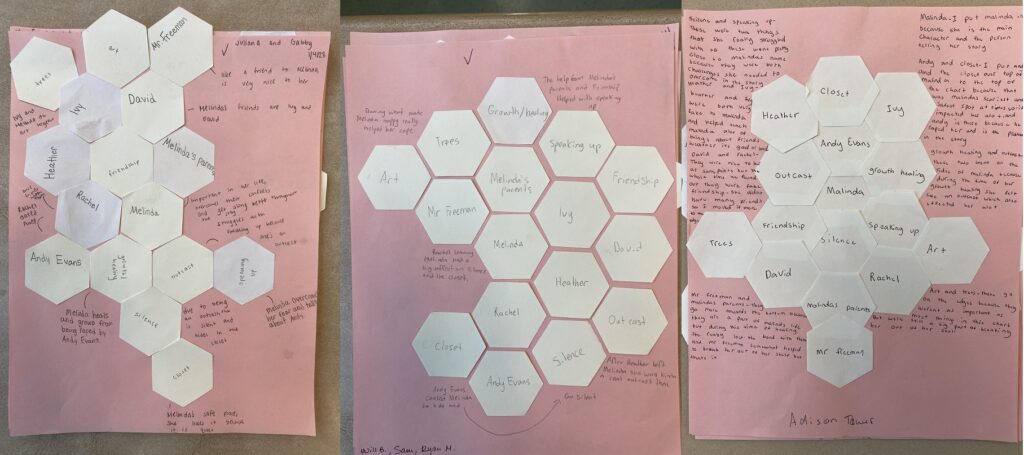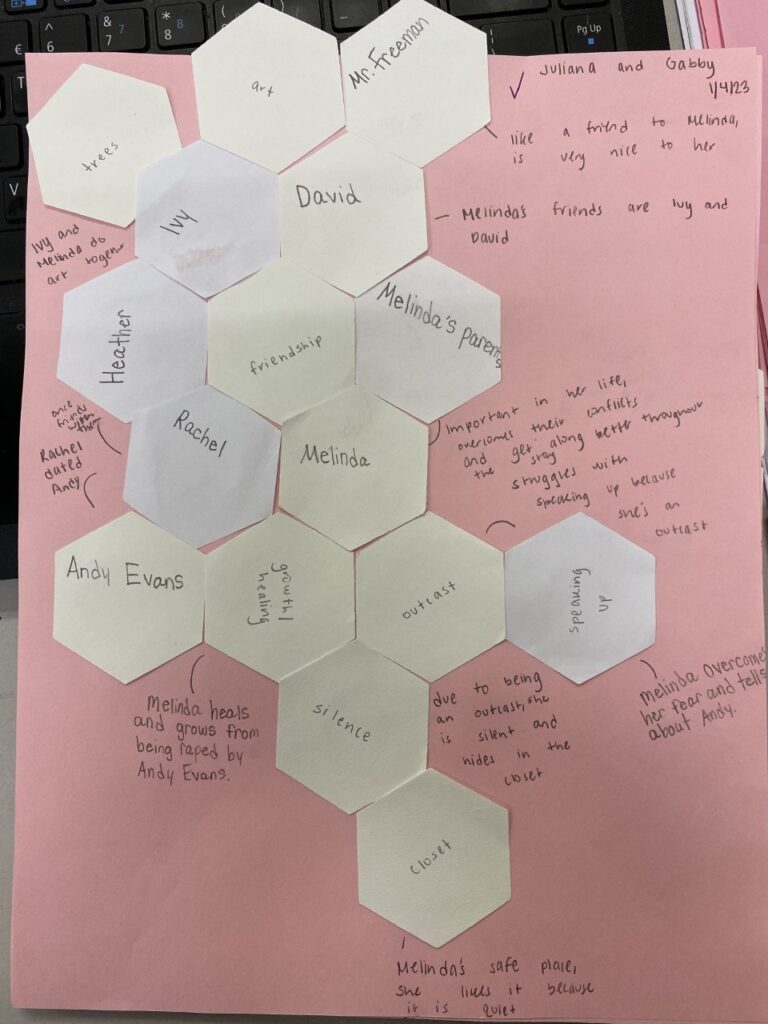This blog post was written by NCTE member Jennifer Bonaldo.
The pandemic has impacted teaching and learning in a myriad of ways. One of the biggest challenges I’ve noticed is students struggling to collaborate in small groups. We spent so much time separating them that many have forgotten how to work together. I’ve been experimenting with different strategies this year to facilitate effective group interaction, and the biggest success I’ve had so far is with an activity called Hexagonal Thinking.
I first read about it in a Cult of Pedagogy post, but I was hesitant. I thought it would require a lot of prep, and I thought it might be too challenging for my ninth graders. I was wrong on both counts.
Let me first explain what hexagonal thinking is and then show you how wrong I was about it.
You begin with a stack of hexagon-shaped pieces of paper. This does take a little time to prep if you do it by hand, but my department head purchased a hexagon cutter, which made this step effortless.
Once you have a stack, you decide what to put on them. This will depend on your objectives for group discussion. Most recently, I used it to help my ninth graders understand themes in Speak by Laurie Halse Anderson. I wrote down a list of important characters, locations, motifs, etc. Looking back, I see that I could have also included key quotations, which I think would have been helpful later on when they used this activity to help them write theme essays. You can also leave some hexagons blank so that students can add their own topics, quotations, etc.
Next, I divided students into groups of three or four, gave each a stack of hexagons, and projected the words. They quickly wrote one word on each hexagon.
Then, I explained the directions. I asked them to work together to decide where to place each hexagon on a piece of paper. Which hexagons should be connected together? Which one should be in the center? Which ones would you group together? Which should be separated? I gave them a few guiding questions like this, and then I set them loose to play.
And this is the cool part. The first time I did this, I thought they would struggle and need a lot of support from me. Many of my students this year (and post-pandemic in general) want a lot of support to get to the “right” answer. I was worried that they would struggle with such an open-ended activity to find the “right” pattern of hexagons or struggle to even get started.
I couldn’t have been more wrong. They jumped right into the activity and did just what I wanted them to do. They played around with different ideas; they tried different organizations and made adjustments; they didn’t ask me for the “right” answer; and the biggest win for me, they collaborated.
The final piece of the activity was for them to justify their thinking. I asked them to write notes next to the hexagons explaining their thinking. For this particular activity, I asked them to write three to four brief explanations, but you can make this step as formal or informal as you want. My goal here was simply to get them brainstorming about themes, so I didn’t require extensive responses. If your objective was practicing argument writing or justifying a claim, you could make this step more significant.
At the end of class, I asked each group to choose and share one choice they made and to explain their thinking. As this lesson was meant as a brainstorming activity to help them develop theme statements for their essays, I did not formally assess it, but you certainly could. You could use this as an assessment for speaking and listening skills, collaboration, and argumentative writing. You can easily tailor it to your class needs and make it as informal or formal as you wish.
My biggest takeaway from this activity is that physical manipulatives can be so helpful in getting students to collaborate and think abstractly. The act of moving the hexagons across the desk activated their brains in a new way and gave them something to do with their hands that motivated them. There was so much active learning going on that I have been striving for in my classroom over the past few years. And it was so easy to make it happen!

And the best part about this activity is how adaptable it is. It can be used at any grade or ability level and with virtually any topic. Here are some other ways you might use it:
- At the beginning of the year with norm setting. Ask students to connect different behaviors or classroom expectations.
- To connect elements of different class texts.
- To explore challenging topics like bias, stereotyping, etc.
- To write poems by connecting different descriptive words.
These are just a few ideas I am considering, but the possibilities are really endless. More than anything, I hope you’ll consider trying it to get your kids talking and thinking with each other in new ways. That was the biggest joy for me.
Jeni Bonaldo has been teaching 9th grade ELA and Creative Writing at Amity Regional Senior High School for 19 years. She is also a writer, professional storyteller, wife, and mom.
It is the policy of NCTE in all publications, including the Literacy & NCTE blog, to provide a forum for the open discussion of ideas concerning the content and the teaching of English and the language arts. Publicity accorded to any particular point of view does not imply endorsement by the Executive Committee, the Board of Directors, the staff, or the membership at large, except in announcements of policy, where such endorsement is clearly specified.

